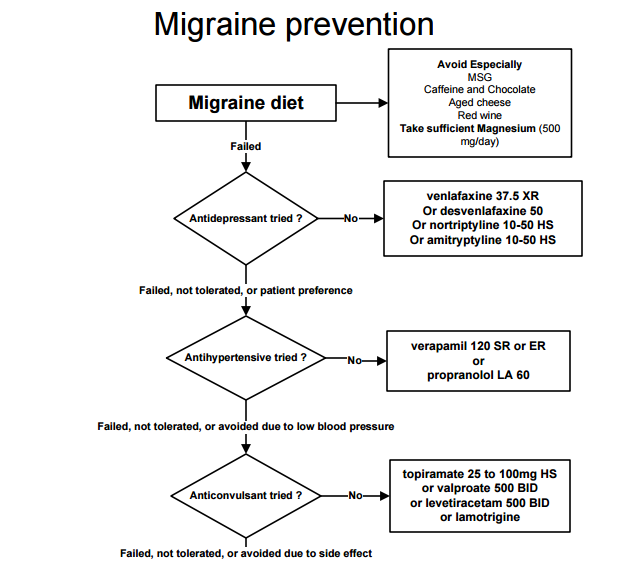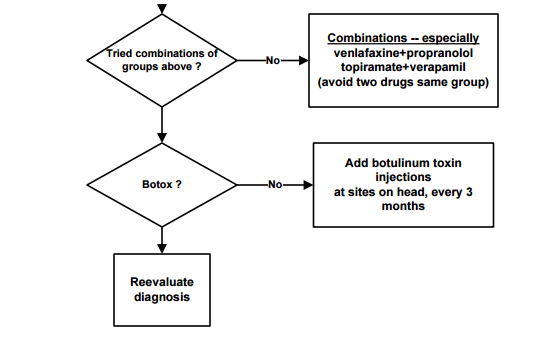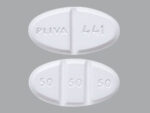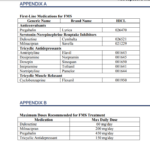Migraine is a “committee disease”, with multiple genetic variants. It seems extremely likely that there is no single drug that will “work” in this collection of several disorders that share some common features. In other words, prevention of migraine is a “trial and error” process.
There are several types of migraines, including:
- Migraine without aura: This is the most common type of migraine, accounting for about 70-90% of cases. It is characterized by moderate to severe pulsating or throbbing pain on one side of the head, often accompanied by nausea, vomiting, and sensitivity to light and sound.
- Migraine with aura: This type of migraine is characterized by visual disturbances, such as flashing lights, zigzag lines, or blind spots, that typically occur before the onset of the headache. Aura symptoms usually last between 5 and 60 minutes and are followed by the headache.
- Chronic migraine: This is a type of migraine that occurs on 15 or more days per month for at least three months, with at least eight of those days being migraine attacks.
- Vestibular migraine: This type of migraine is characterized by dizziness or vertigo, often accompanied by nausea and difficulty with balance.
- Hemiplegic migraine: This is a rare type of migraine that can cause temporary paralysis or weakness on one side of the body, often mimicking a stroke.
- Menstrual migraine: This type of migraine is linked to hormonal changes during the menstrual cycle and tends to occur just before or during menstruation.
- Ocular migraine: This is a type of migraine that affects the vision, causing temporary visual disturbances or even temporary vision loss in one eye.
- It’s important to note that there is some overlap between these types, and some people may experience multiple types of migraines. It’s also possible for migraine symptoms to change over time.
For those who have more than 2 severe headaches/month and in patients with complicated migraine (migraine with stroke-like features), a daily medication may be worth while. These are generally highly effective (about 75% effective), but do require daily regular use.
Only about 3-5% of migraine patients use prevention medications, according to Gray (1999).
These drugs fall into four major classes:
- anticonvulsants,
- antidepressants,
- antihypertensives,
Examples are: Amitriptyline (Elavil), Botox, Depakote and Topiramate, Inderal, Nardil and Venlafaxine, Verapamil (Calan, Isoptin).
These drugs seem to work via several pathways: some are beta-blockers (e.g. Inderal, Corguard), some are calcium channel blockers (e.g. verapamil). Some work on electrical activity in the brain(e.g. topiramate). Some in mysterious ways, possibly through manipulations of serotonin(e.g. Nardil, amitriptyline, venlafaxine). More information about these is in the next section.
Migraine is a “committee disease”, with multiple genetic variants. It seems extremely likely that there is no single drug that will “work” in this collection of several disorders that share some common features. In other words, prevention of migraine is a “trial and error” process.
To use these drugs it is best to have a measure of effect.
One way is to use a headache diary. Here we recommend a month/page style format, and a stoplight; color code – – red bad, yellow — fair, green good. Another is to do it online
Our approach to migraine prevention and use of these drugs can be found by clicking on the flowchart above.
We also can point the reader to an extensive online review published in 1999 by a US government agency, and found on the NCBI bookshelf. Although it is extremely dated (i.e. somebody should put out a newer edition), it still summarizes an immense amount of data.
How to Prevent Migraine ?
There are several strategies that can help prevent migraines or reduce their frequency and severity:
- Identify triggers: Keep a migraine diary to track your symptoms and identify any triggers that may be causing your migraines. Common triggers include stress, lack of sleep, certain foods or drinks, hormonal changes, and environmental factors such as bright lights or strong smells.
- Make lifestyle changes: Making healthy lifestyle changes can help reduce the frequency and severity of migraines. This can include getting regular exercise, practicing stress-reducing techniques such as meditation or yoga, and maintaining a consistent sleep schedule.
- Avoid trigger foods: Certain foods and drinks can trigger migraines in some people. Common triggers include caffeine, alcohol, chocolate, aged cheeses, and foods containing MSG or nitrates.
- Take preventive medication: There are several medications that can be taken daily to help prevent migraines. These include beta-blockers, antidepressants, anticonvulsants, and CGRP inhibitors.
- Use acute treatment: Over-the-counter pain relievers such as aspirin, ibuprofen, and acetaminophen can be effective for treating mild to moderate migraines. Prescription medications such as triptans or ergotamines may be necessary for more severe migraines.
- Consider alternative therapies: Certain alternative therapies, such as acupuncture, biofeedback, or massage, may be helpful in reducing migraine symptoms for some people.
It’s important to work with a healthcare provider to develop a personalized migraine prevention plan that takes into account your individual triggers and symptoms.
Prevent Medicines for Migraines
There are several preventive medications available for migraines that can be effective in reducing the frequency, severity, and duration of migraines. These include:
- Beta-blockers: These medications, which are commonly used to treat high blood pressure, can also be effective in preventing migraines. They work by blocking the effects of adrenaline on the body and reducing the frequency and severity of migraines.
- Antidepressants: Certain antidepressants, such as amitriptyline and venlafaxine, can be effective in preventing migraines, even in people who do not have depression.
- Anticonvulsants: Certain anticonvulsants, such as topiramate and valproate, can be effective in preventing migraines by reducing the hyperexcitability of nerve cells in the brain.
- CGRP inhibitors: These are a relatively new class of medications that block the effects of calcitonin gene-related peptide, a molecule that is believed to play a role in the development of migraines. These medications, which are given by injection or infusion, can be effective in preventing migraines in some people.
It’s important to work with a healthcare provider to determine which preventive medication is right for you, as the effectiveness and side effects of these medications can vary from person to person. In addition, it may take several weeks or even months to determine if a particular medication is effective in preventing migraines.
Pain Medications, Pain Relief, and Pain Management










